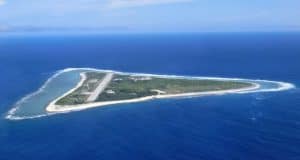
TOKYO — Aiming to reduce its reliance on China for rare earth metals, Japan will begin in 2024 to extract the essential materials for electric vehicles and hybrids from the mud on the deep sea bottom in an area off Minami-Torishima Island, a coral atoll in the Pacific Ocean about 1,900 kilometers southeast of Tokyo.
Tokyo plans to begin work to develop extraction technologies starting next year.
Mud rich in rare earth metals has been found on the seafloor at a depth of 6,000 meters in the target area. To get at it, Japan first needs to develop technologies to extract the resources from depths of 5,000-6,000 meters.
The kuroshio, or Japan Current, known to be among the world’s fastest sea currents, passes the target area, which is also located in the path of typhoons. Experts say there are high technological hurdles for any endeavor to extract resources from deep-sea locations in such tough conditions.
When extracting oil and natural gas from seafloor sites, the deposits are under strong pressure, which pushes the resources out once a hole drilled from the surface reaches them. However, mud containing rare earth metals does not have this advantage, so it requires some means to bring it up to the surface, such as pumping, for example.
The Japanese Diet approved an allocation of 6 billion yen ($44 million) for the project in the second supplementary budget for fiscal 2022 recently approved in an extraordinary session. The money will be spent on the development of pumps and making pipe as long as 6,000 meters to be used in trial extraction.
Research work to extract resources in the Minami-Torishima area is underway under the Cabinet Office’s Cross-ministerial Strategic Innovation Promotion Program. Researchers succeeded in pumping up deposits from a 2,470-meter-deep seabed in a period from August to September.
Rare earth is a blanket term referring to 17 rare metals. Japan currently relies on imports for nearly all its rare metal needs, including 60% from China. Chinese imports include neodymium, an essential material used in wind power generation, and dysprosium, used in electric vehicle motors.
The new National Security Strategy announced last Friday states: “Japan will curb excessive dependence on specific countries, carry forward next-generation semiconductor development and manufacturing bases, and secure stable supply for critical goods, including rare earths.”
The government on Tuesday designated 11 areas of “specified critical materials,” including rare earths, under the Law for the Promotion of Economic Security enacted this year.
